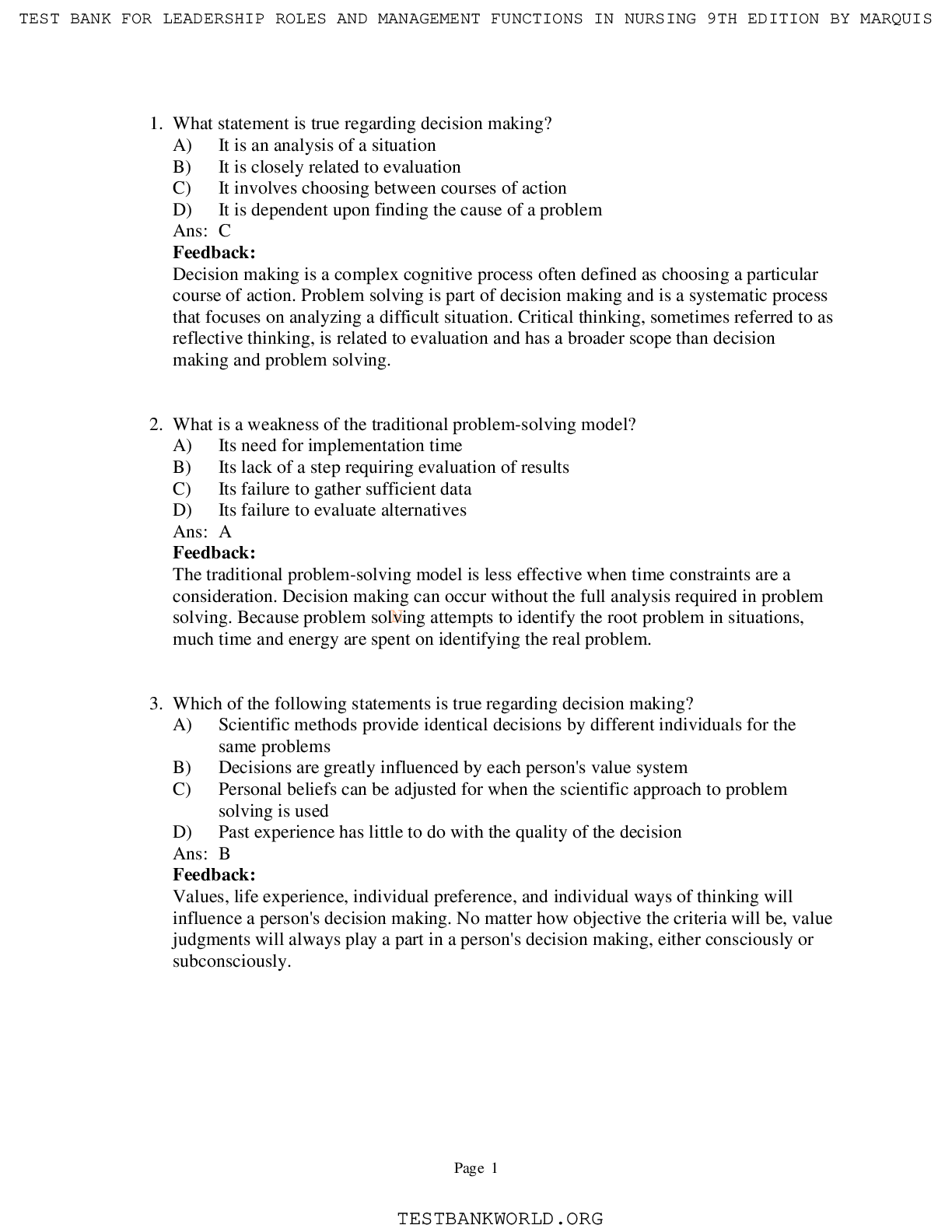1. What statement is true regarding decision making?
A) It is an analysis of a situation
B) It is closely related to evaluation
C) It involves choosing between courses of action
D) It is dependent upon finding the cause of a problem
Ans: C
Feedback:
Decision making is a complex cognitive process often defined as choosing a particular
course of action. Problem solving is part of decision making and is a systematic process
that focuses on analyzing a difficult situation. Critical thinking, sometimes referred to as
reflective thinking, is related to evaluation and has a broader scope than decision
making and problem solving.
2. What is a weakness of the traditional problem-solving model?
A) Its need for implementation time
B) Its lack of a step requiring evaluation of results
C) Its failure to gather sufficient data
D) Its failure to evaluate alternatives
Ans: A
Feedback:
The traditional problem-solving model is less effective when time constraints are a
consideration. Decision making can occur without the full analysis required in problem
solving. Because problem solving attempts to identify the root problem in situations,
much time and energy are spent on identifying the real problem.
3. Which of the following statements is true regarding decision making?
A) Scientific methods provide identical decisions by different individuals for the
same problems
B) Decisions are greatly influenced by each person's value system
C) Personal beliefs can be adjusted for when the scientific approach to problem
solving is used
D) Past experience has little to do with the quality of the decision
Ans: B
Feedback:
Values, life experience, individual preference, and individual ways of thinking will
influence a person's decision making. No matter how objective the criteria will be, value
judgments will always play a part in a person's decision making, either consciously or
subconsciously.
4. What influences the quality of a decision most often?
A) The decision maker's immediate superior
B) The type of decision that needs to be made
C) Questions asked and alternatives generated
D) The time of day the decision is made
Ans: C
Feedback:
The greater the number of alternatives that can be generated by the decision maker, the
better the final decision will be. The alternatives generated and the final choices are
limited by each person's value system.
5. What does knowledge about good decision making lead one to believe?
A) Good decision makers are usually right-brain, intuitive thinkers
B) Effective decision makers are sensitive to the situation and to others
C) Good decisions are usually made by left-brain, logical thinkers
D) Good decision making requires analytical rather than creative processes
Ans: B
Feedback:
Good decision makers seem to have antennae that make them particularly sensitive to
other people and situations. Left-brain thinkers are typically better at processing
language, logic, numbers, and sequential ordering, whereas right-brain thinkers excel at
nonverbal ideation and holistic synthesizing.
6. What is the best definition of decision making?
A) The planning process of management
B) The evaluation phase of the executive role
C) One step in the problem-solving process
D) Required to justify the need for scarce items
Ans: C
Feedback:
Decision making is a complex, cognitive process often defined as choosing a particular
course of action. Decision making, one step in the problem-solving process, is an
important task that relies heavily on critical thinking and clinical reasoning skills.
7. If decision making is triggered by a problem with what does it end?
A) An alternative problem
B) A chosen course of action
C) An action that guarantees success
D) A restatement of the solution
Ans: B
Feedback:
A decision is made when a course of action has been chosen. Problem solving is part of
decision making and is a systematic process that focuses on analyzing a difficult
situation. Problem solving always includes a decision-making step.
8. Why do our values often cause personal conflict in decision making?
A) Some values are not realistic or healthy
B) Not all values are of equal worth
C) Our values remain unchanged over time
D) Our values often collide with one another
Ans: D
Feedback:
Values, life experience, individual preference, and individual ways of thinking will
influence a person's decision making. No matter how objective the criteria will be, value
judgments will always play a part in a person's decision making, either consciously or
subconsciously.
9. Which statement is true concerning critical thinking?
A) It is a simple approach to decision making
B) It is narrower in scope than decision making
C) It requires reasoning and creative analysis
D) It is a synonym for the problem-solving process
Ans: C
Feedback:
Critical thinking has a broader scope than decision making and problem solving. It is
sometimes referred to as reflective thinking. Critical thinking also involves reflecting
upon the meaning of statements, examining the offered evidence and reasoning, and
forming judgments about facts.
10. How do administrative man managers make the majority of their decisions?
A) After gathering all the facts
B) In a manner good enough to solve the problem
C) In a rational, logical manner
D) After generating all the alternatives possible
Ans: B
Feedback:
Many managers make decisions that are just “good enough” because of lack of time,
energy, or creativity to generate a number of alternatives. This is also called
“satisficing.” Most people make decisions too quickly and fail to systematically
examine a problem or its alternatives for solution.
11. What needs to be considered in evaluating the quality of one's decisions?
A) Is evaluation necessary when using a good decision-making model?
B) Can evaluation be eliminated if the problem is resolved?
C) Will the effectiveness of the decision maker be supported?
D) Will the evaluation be helpful in increasing one's decision-making skills?
Ans: D
Feedback:
The evaluation phase is necessary to find out more about one's ability as a decision
maker and to find out where the decision making was faulty.
12. Which statement concerning the role of the powerful in organizational decision making
is true?
A) They exert little influence on decisions that are made
B) They make decisions made that are in congruence with their own values
C) They allow others to make the decisions however they wish
D) They make all the important decisions with consideration to others
Ans: B
Feedback:
Not only does the preference of the powerful influence decisions of others in the
organization, but the powerful are also able to inhibit the preferences of the less
powerful. Powerful people in organizations are more likely to have decisions made that
are congruent with their own preferences and values.
Read More


